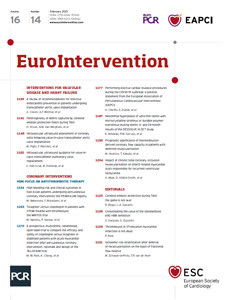
Cerebrovascular accidents (CVA), mainly stroke, are still one of the Achilles’ Heels of transcatheter aortic valve implantation (TAVI) procedures; however, clinically evident strokes are not the only concern. TAVI procedures have also been associated with covert cerebral emboli captured on transcranial Doppler as high-intensity transient signals (HITS) and ultimately defined as silent brain infarcts, as documented on diffusion-weighted imaging magnetic resonance imaging (DWI-MRI)1,2. Notably, the incidence of silent brain infarcts is very much higher (up to 90%)1 than that of clinically evident strokes, which ranges from 0%3 to 2.3-2.5% at 30 days4.
The risk of periprocedural cerebrovascular complications in patients undergoing TAVI has led to the development of cerebral embolic protection devices (CEPD). In this issue of EuroIntervention, Kroon et al5 report the results of an observational study investigating the amount, size and heterogeneity of debris captured (filtered) by the SENTINEL™ CEPD (Boston Scientific, Marlborough, MA, USA) among patients undergoing TAVI with three different TAVI devices. A total of 328 patients underwent protected TAVI with either the EVOLUT™ R/PRO (n=123; Medtronic, Minneapolis, MN, USA), SAPIEN 3 (n=113; Edwards Lifesciences, Irvine, CA, USA) or Lotus™ valve (n=92; Boston Scientific).
Debris was captured in 98% of patients and no significant differences were observed in terms of the presence of collagen and thrombus. The mechanically expandable Lotus valve resulted in less debris derived from the aortic valve (Lotus 58% vs SAPIEN 3 69% and EVOLUT R/PRO 81%), but more calcific material (33% vs 12% and 24%), as well as endothelial (49% vs 30% and 16%) and myocardial tissue (19% vs 11% and 2%). Foreign material was most commonly found with use of the Lotus valve (62% vs 40% and 47%), whereas calcified and foreign material were less frequently found with the balloon-expandable SAPIEN 3 valve, and myocardial and endothelial tissue was less frequently captured with use of the self-expanding EVOLUT R/PRO valves.
Differences in debris captured by the dual-filter CEPD based on the type of TAVI device
Seeger et al6 showed that the proportion of patients with large debris (≥1,000 µm) was higher among individuals receiving the SAPIEN 3 valve compared to those treated with EVOLUT R or Lotus valves. The amount of debris was significantly lower with the Lotus valve compared with the EVOLUT R and SAPIEN 3 valves. Pooled data from two prospective studies (SENTINEL [Cerebral Protection in Transcatheter Aortic Valve Replacement] trial, n=100 and SENTINEL-H [Histopathology of Embolic Debris Captured During Transcatheter Aortic Valve Replacement] trial, n=146) showed that debris was captured in 99% of patients and 53% had at least one particle of debris >1 mm7. In contrast to the above-mentioned findings, individuals receiving EVOLUT R or Lotus valves presented with a greater number and size of particles captured by the CEPD relative to those receiving the SAPIEN valve7. Importantly, this study also found, after multivariate analyses, that the TAVI type was the only variable associated with the amount of debris captured (p≤0.01)7.
The study of Kroon and colleagues5 is very informative from the clinical and mechanistic perspectives and is in line with the work of Schmidt et al discussed above7. Indeed, the authors showed larger debris (≥1,000 µm) mostly captured after TAVI with the Lotus valve (36% of patients) and least with the SAPIEN 3 valve (19%). Moreover, in multivariable analysis, the Lotus valve showed the highest risk of dislodging particles ≥1,000 µm (OR 2.44, 95% CI: 1.14-5.24), while the EVOLUT R/PRO and SAPIEN 3 were comparable (OR 1.04, 95% CI: 0.46-2.33). Interestingly, valve repositioning during TAVI was associated with greater amounts of debris captured by the SENTINEL CEPD (OR 2.96, 95% CI: 1.42-6.16), whereas there was no association with larger particles (OR 1.35, 95% CI: 0.77-2.39). Notably, Kroon et al5 also showed that the presence of a functional bicuspid aortic valve significantly increased the risk for larger particles being captured by the CEPD (OR 2.91, 95% CI: 1.20-7.03).
Mechanistic insights behind differences in debris captured after TAVI
A pioneer study by Kahlert et al8 showed that most HITS identified on transcranial Doppler were detected during the valve implantation step. From that report onwards, the findings of Kroon et al5 as well as those presented by Schmidt and colleagues7 are consistent from a device-related mechanistic and procedural perspective. Greater debris was captured in the CEPD of patients receiving Lotus and EVOLUT R/PRO devices since they both need a stepwise implantation technique, including more often balloon predilation. Hence, there is greater intervention/manipulation on the aortic valve/annulus before releasing the transcatheter valve, as opposed to the SAPIEN 3 valve that usually takes a simple shot. The same fundamentals apply for recapturing and repositioning the former two transcatheter valves and this is supported by the findings of Kroon et al5. In addition, data from the SENTINEL trial9 already showed that participants who received the SAPIEN 3 valve had a smaller volume of acute lesions detected on DWI-MRI compared with EVOLUT R counterparts.
Debris capture and clinically apparent neurological impairment after TAVI
Kroon et al5 report a 1.2% rate of stroke (assumed to be in-hospital). This low rate is similar to other selected populations who underwent protected TAVI but also to a recent large registry where the in-hospital rate of stroke was less than 2%4. Several analyses have been published thus far showing ambiguous results. This is mainly due to the heterogeneity of the data with regard to definitions of stroke, the time frame for its diagnosis and whether the clinical adjudication of stroke was carried out independently by a neurologist10,11,12. Even though there is an interesting conceptual background for the use of CEPD, the SENTINEL dual-filter CEPD does not protect the posterior territory while other CEPDs, also known as deflectors, do2. Therefore, since embolic lesions are often multiple and affect both cerebral hemispheres and different vascular territories10, the ascertainment of strokes related to unprotected, protected, or anterior versus posterior territories is still under debate. In addition, the use of CEPD should protect against procedure-related cerebral embolism; therefore, the clinical adjudication of stroke at 7 or 30 days1,10,11 does not reflect such a period, where, for instance, the impact of atrial fibrillation and the periprocedural/discharge management of anticoagulation would also play a role.
The use of CEPD during TAVI has been consistently associated with the capture of debris that is otherwise en route to the brain. However, there is still a lack of correlation with clinically evident strokes and other neurological outcomes such as cognitive impairment. This issue may be explained by the decrease in stroke rates with newer-generation TAVI devices4,11, but also by the lack of systematic neurologic assessment and a dedicated/standardised battery for longitudinal cognitive function assessment12.
In summary, the results of Kroon et al5 highlight the fact that there are specific TAVI-type mechanistics that will certainly inspire future decision making. Despite a large randomised controlled trial with the SENTINEL CEPD being underway (https://clinicaltrials.gov/ct2/show/NCT04149535), the randomisation will not consider TAVI types, hence it will not be powered to provide a definitive answer to this relevant question. Furthermore, one major uncertainty that still remains, perhaps the most relevant, is the lack of a preprocedural prediction model to help identify patients who would benefit the most from protected TAVI. Hence, there seems to be a long road ahead before the routine use of CEPD (if ever) during TAVI.
Conflict of interest statement
The authors have no conflicts of interest to declare.
Supplementary data
To read the full content of this article, please download the PDF.

